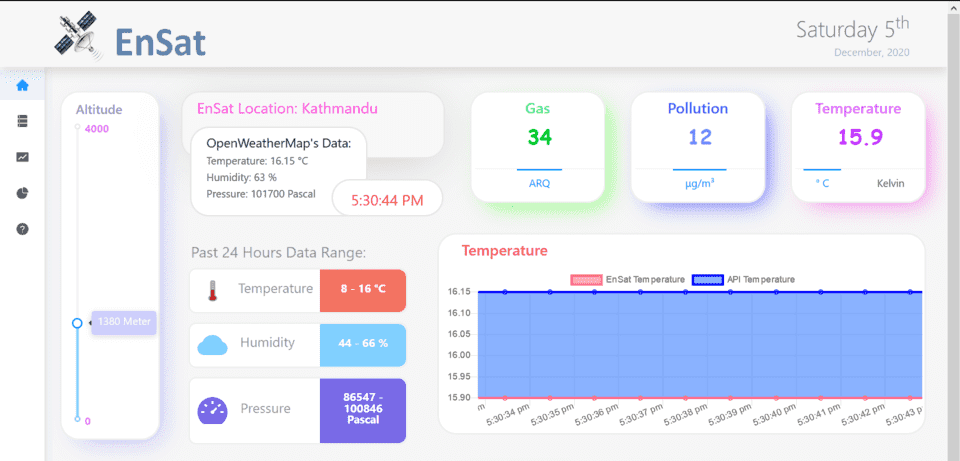EnSat
Rachelle Palmer3 min read • Published May 20, 2022 • Updated Feb 08, 2023
FULL APPLICATION
Ashish Adhikari, Awan Shrestha, Sabil Shrestha and Sansrit Paudel from Kathmandu University in Nepal contributed this project.
EnSat (Originally, the project was started with the name "PicoSat," and changed later to "EnSat") is a miniature version of an Environmental Satellite which helps to record and analyze the environmental parameters such as altitude, pressure, temperature, humidity, and pollution level.
Access this project in Githubhere.
I was always very interested in how things work. We had a television when I was young, and there were all these wires connected to the television. I was fascinated by how the tv worked and how this could show moving images. I always wondered about things like these as a child. I studied this, and now I’m in college learning more about it. For this project, I wanted to do something that included data transfer at a very low level.
My country is not so advanced technologically. But last year, Nepal’s first satellite was launched into space. That inspired me. I might not be able to do that same thing now, but I wanted to try something smaller, and I built a miniature satellite. And that’s how this project came to be. I was working on the software, and my friends were working on the hardware, and that’s how we collaborated.
We had our Professor Dr. Gajendra Sharma supervising the project, but we were free to choose whatever we wanted. For the first time in this project, I used MongoDB; before that, I was not familiar with MongoDB. I was also not used to the GUI react part; while I was learning React, the course also included MongoDB. Before this project, I was using MySQL, I was planning on using MySQL again, but after following this course, I decided to switch to MongoDB. And this was good; transferring the data and storing the data is so much more comfortable with MongoDB. With MongoDB, we only have to fetch the data from the database and send it. The project is quite complicated, but MongoDB made it so much easier on the software level, so that’s why we chose MongoDB for the project.
A satellite with a microcontroller and sensors transmits the environmental data to Ground Station through radio frequency using ISM band 2.4 GHz. The Ground Station has a microcontroller and receiver connected to a computer where the data is stored in the MongoDB database. The API then fetches data from the database providing live data and history data of the environmental parameters. Using the data from API, the information is shown in the GUI built in React. This was our group semester project where the Serialport package for data communication, MongoDB for database, and React was used for the GUI. Our report in the GitHub repository can also tell you more in detail how everything works.
It is a unique and different project, and it is our small effort to tackle the global issue of climate change and environmental pollution. The project includes both hardware and software parts. EnSat consists of multidisciplinary domains. Creating it was a huge learning opportunity for us as we made our own design and architecture for the project's hardware and software parts. This project can inspire many students to try MongoDB with skills from different domains and try something good for our world.
There was one challenging part, and I was stuck for three days. It made me build my own serial data port to be able to get data in the server. That was a difficult time. With MongoDB, there was not any difficulty. It made the job so much easier.
It’s also nice to share that we participated in three competitions and that we won three awards. One contest was where the satellite is actually dropped from the drone from the height, and we have to capture the environmental data at different heights as it comes down. It was the first competition of that kind in my country, and we won that one. We won another one for the best product and another for the best product under the Advancing Towards Smart Cities, Sustainable Development Goals category.
I learned so many things while working on this project. Not only React and MongoDB, but I also learned everything around the hardware: Arduino programming, programming C for Arduino, the hardware level of programming. And the most important thing I learned is never to give up. At times it was so frustrating and difficult to get everything running. If you want to do something, keep on trying, and sometimes it clicks in your mind, and you just do it, and it happens.
I’m glad that MongoDB is starting programs for Students. These are the kind of things that motivate us. Coming from a not so developed country, we sometimes feel a bit separated. It’s so amazing that we can actually take part in this kind of program. It’s the most motivating factor in doing engineering and studying engineering. Working on these complex projects and then being recognized by MongoDB is a great motivation for all of us.

